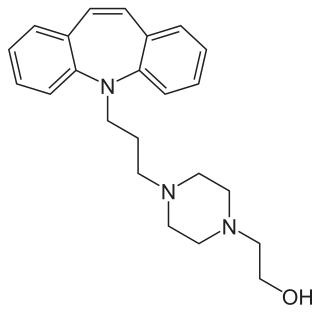Related Research Articles

Fluvoxamine, sold under the brand name Luvox among others, is an antidepressant of the selective serotonin reuptake inhibitor (SSRI) class. It is primarily used to treat major depressive disorder and, perhaps more-especially, obsessive–compulsive disorder (OCD), but is also used to treat anxiety disorders such as panic disorder, social anxiety disorder, and post-traumatic stress disorder.

Buspirone, sold under the brand name Buspar among others, is an anxiolytic, a medication primarily used to treat anxiety disorders, particularly generalized anxiety disorder (GAD). It is a serotonin 5-HT1A receptor partial agonist, increasing action at serotonin receptors in the brain. It is taken orally and takes two to six weeks to be fully effective.

Riluzole is a medication used to treat amyotrophic lateral sclerosis (ALS) and other motor neuron diseases. Riluzole delays the onset of ventilator-dependence or tracheostomy in some people and may increase survival by two to three months. Riluzole is available in tablet and liquid form.

Agomelatine, sold under the brand names Valdoxan and Thymanax, among others, is an atypical antidepressant most commonly used to treat major depressive disorder and generalized anxiety disorder. One review found that it is as effective as other antidepressants with similar discontinuation rates overall but fewer discontinuations due to side effects. Another review also found it was similarly effective to many other antidepressants.

Alpidem, sold under the brand name Ananxyl, is a nonbenzodiazepine anxiolytic medication which was briefly used to treat anxiety disorders but is no longer marketed. It was previously marketed in France, but was discontinued due to liver toxicity. Alpidem is taken by mouth.

Lofepramine, sold under the brand names Gamanil, Lomont, and Tymelyt among others, is a tricyclic antidepressant (TCA) which is used to treat depression. The TCAs are so named as they share the common property of having three rings in their chemical structure. Like most TCAs lofepramine is believed to work in relieving depression by increasing concentrations of the neurotransmitters norepinephrine and serotonin in the synapse, by inhibiting their reuptake. It is usually considered a third-generation TCA, as unlike the first- and second-generation TCAs it is relatively safe in overdose and has milder and less frequent side effects.

Opipramol, sold under the brand name Insidon among others, is an anxiolytic and tricyclic antidepressant that is used throughout Europe. Despite chemically being a tricyclic dibenzazepine (iminostilbene) derivative similar to imipramine, opipramol is not a monoamine reuptake inhibitor like most other tricyclic antidepressants, and instead, uniquely among antidepressants, acts primarily as a SIGMAR1 agonist. It was developed by Schindler and Blattner in 1961.

Desmetramadol, also known as O-desmethyltramadol (O-DSMT), is an opioid analgesic and the main active metabolite of tramadol. Tramadol is demethylated by the liver enzyme CYP2D6 to desmetramadol in the same way as codeine, and so similarly to the variation in effects seen with codeine, individuals who have a less active form of CYP2D6 will tend to have reduced analgesic effects from tramadol. Because desmetramadol itself does not need to be metabolized to induce an analgesic effect, it can be used in individuals with CYP2D6 inactivating mutations.

Vortioxetine, sold under the brand name Trintellix and Brintellix among others, is an antidepressant of the serotonin modulator and stimulator (SMS) class. Its effectiveness is viewed as similar to that of other antidepressants. It is taken orally.
An orexin receptor antagonist, or orexin antagonist, is a drug that inhibits the effect of orexin by acting as a receptor antagonist of one (selective orexin receptor antagonist or SORA) or both (dual orexin receptor antagonis or DORA) of the orexin receptors, OX1 and OX2. Medical applications include treatment of sleep disorders such as insomnia.

Hydroxybupropion, or 6-hydroxybupropion, is the major active metabolite of the antidepressant and smoking cessation drug bupropion. It is formed from bupropion by the liver enzyme CYP2B6 during first-pass metabolism. With oral bupropion treatment, hydroxybupropion is present in plasma at area under the curve concentrations that are as many as 16 to 20 times greater than those of bupropion itself, demonstrating extensive conversion of bupropion into hydroxybupropion in humans. As such, hydroxybupropion is likely to play a very important role in the effects of oral bupropion, which could accurately be thought of as functioning largely as a prodrug to hydroxybupropion.

R7 is a small-molecule flavonoid and orally active, potent, and selective agonist of the tropomyosin receptor kinase B (TrkB) – the main signaling receptor for the neurotrophin brain-derived neurotrophic factor (BDNF) – which is under development for the treatment of Alzheimer's disease. It is a structural modification and prodrug of tropoflavin (7,8-DHF) with improved potency and pharmacokinetics, namely oral bioavailability and duration.

Dinalbuphine sebacate (DNS), also known as nalbuphine sebacate or as sebacoyl dinalbuphine ester (SDE) and sold under the brand name Naldebain, is a non-controlled opioid analgesic which is used as a 7-day long-acting injection in the treatment of moderate to severe postoperative pain.
CYB004, or CYB-004, also known as deuterated dimethyltryptamine (dDMT), is a serotonergic psychedelic related to dimethyltryptamine (DMT) which is under development for the treatment of generalized anxiety disorder. It is administered by inhalation or intravenous injection.
FKW00GA, also known as TGW00AA, is a serotonin 5-HT1A receptor partial agonist and serotonin 5-HT2A receptor antagonist which is under development for the treatment of generalized anxiety disorder, social phobia, and sexual dysfunction. It is taken by mouth.
MSP-1014 is a serotonergic psychedelic which is under development for the treatment of major depressive disorder, other depressive disorders, and anxiety disorders.
BMB-201 is a serotonin 5-HT2A and 5-HT2C receptor agonist described as a non-hallucinogenic psychoplastogen which is under development for the treatment of depression, anxiety, pain, and other indications.
References
- 1 2 3 4 5 6 7 "SPT-320 - Seaport Therapeutics". AdisInsight. 2 January 2024. Retrieved 14 January 2025.
- 1 2 3 4 5 "Delving into the Latest Updates on SPT-320 with Synapse". Synapse. 21 November 2024. Retrieved 14 January 2025.
By leveraging Glyph, SPT-320 bypasses liver first-pass metabolism, allowing for lower dosing and reduced liver exposure.